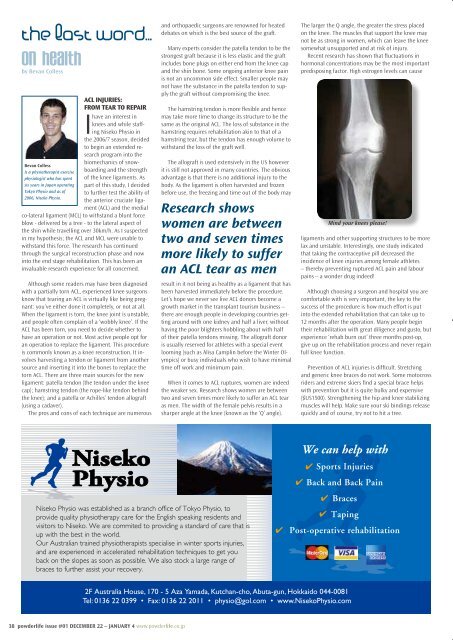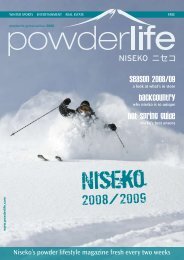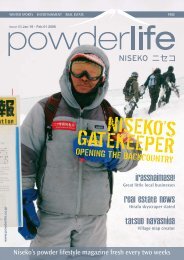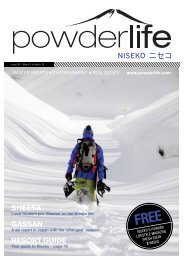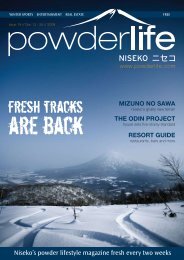Download (15.79 MB) - Powderlife
Download (15.79 MB) - Powderlife
Download (15.79 MB) - Powderlife
Create successful ePaper yourself
Turn your PDF publications into a flip-book with our unique Google optimized e-Paper software.
the last word…on Healthby Bevan CollessBevan CollessIs a physiotherapist exercisephysiologist who has spentsix years in Japan operatingTokyo Physio and as of2006, Niseko Physio.ACL INJURIES:FROM TEAR TO REPAIRIhave an interest inknees and while staffingNiseko Physio inthe 2006/7 season, decidedto begin an extended researchprogram into thebiomechanics of snowboardingand the strengthof the knee ligaments. Aspart of this study, I decidedto further test the ability ofthe anterior cruciate ligament(ACL) and the medialco-lateral ligament (MCL) to withstand a blunt forceblow - delivered by a tree - to the lateral aspect ofthe shin while travelling over 30km/h. As I suspectedin my hypothesis; the ACL and MCL were unable towithstand this force. The research has continuedthrough the surgical reconstruction phase and nowinto the end stage rehabilitation. This has been aninvaluable research experience for all concerned.Although some readers may have been diagnosedwith a partially torn ACL, experienced knee surgeonsknow that tearing an ACL is virtually like being pregnant:you’ve either done it completely, or not at all.When the ligament is torn, the knee joint is unstable,and people often complain of a ‘wobbly knee’. If theACL has been torn, you need to decide whether tohave an operation or not. Most active people opt foran operation to replace the ligament. This procedureis commonly known as a knee reconstruction. It involvesharvesting a tendon or ligament from anothersource and inserting it into the bones to replace thetorn ACL. There are three main sources for the newligament: patella tendon (the tendon under the kneecap); hamstring tendon (the rope-like tendon behindthe knee); and a patella or Achilles’ tendon allograft(using a cadaver).The pros and cons of each technique are numerousand orthopaedic surgeons are renowned for heateddebates on which is the best source of the graft.Many experts consider the patella tendon to be thestrongest graft because it is less elastic and the graftincludes bone plugs on either end from the knee capand the shin bone. Some ongoing anterior knee painis not an uncommon side effect. Smaller people maynot have the substance in the patella tendon to supplythe graft without compromising the knee.The hamstring tendon is more flexible and hencemay take more time to change its structure to be thesame as the original ACL. The loss of substance in thehamstring requires rehabilitation akin to that of ahamstring tear, but the tendon has enough volume towithstand the loss of the graft well.The allograft is used extensively in the US howeverit is still not approved in many countries. The obviousadvantage is that there is no additional injury to thebody. As the ligament is often harvested and frozenbefore use, the freezing and time out of the body mayResearch showswomen are betweentwo and seven timesmore likely to sufferan ACL tear as menresult in it not being as healthy as a ligament that hasbeen harvested immediately before the procedure.Let’s hope we never see live ACL donors become agrowth market in the transplant tourism business –there are enough people in developing countries gettingaround with one kidney and half a liver, withouthaving the poor blighters hobbling about with halfof their patella tendons missing. The allograft donoris usually reserved for athletes with a special eventlooming (such as Alisa Camplin before the Winter Olympics)or busy individuals who wish to have minimaltime off work and minimum pain.When it comes to ACL ruptures, women are indeedthe weaker sex. Research shows women are betweentwo and seven times more likely to suffer an ACL tearas men. The width of the female pelvis results in asharper angle at the knee (known as the ‘Q’ angle).The larger the Q angle, the greater the stress placedon the knee. The muscles that support the knee maynot be as strong in women, which can leave the kneesomewhat unsupported and at risk of injury.Recent research has shown that fluctuations inhormonal concentrations may be the most importantpredisposing factor. High estrogen levels can causeMind your knees please!ligaments and other supporting structures to be morelax and unstable. Interestingly, one study indicatedthat taking the contraceptive pill decreased theincidence of knee injuries among female athletes– thereby preventing ruptured ACL pain and labourpains – a wonder drug indeed!Although choosing a surgeon and hospital you arecomfortable with is very important, the key to thesuccess of the procedure is how much effort is putinto the extended rehabilitation that can take up to12 months after the operation. Many people begintheir rehabilitation with great diligence and gusto, butexperience ‘rehab burn out’ three months post-op,give up on the rehabilitation process and never regainfull knee function.Prevention of ACL injuries is difficult. Stretchingand generic knee braces do not work. Some motocrossriders and extreme skiers find a special brace helpswith prevention but it is quite bulky and expensive($US1500). Strengthening the hip and knee stabilizingmuscles will help. Make sure your ski bindings releasequickly and of course, try not to hit a tree.38 powderlife issue #01 DECE<strong>MB</strong>ER 22 – JANUARY 4 www.powderlife.co.jp


